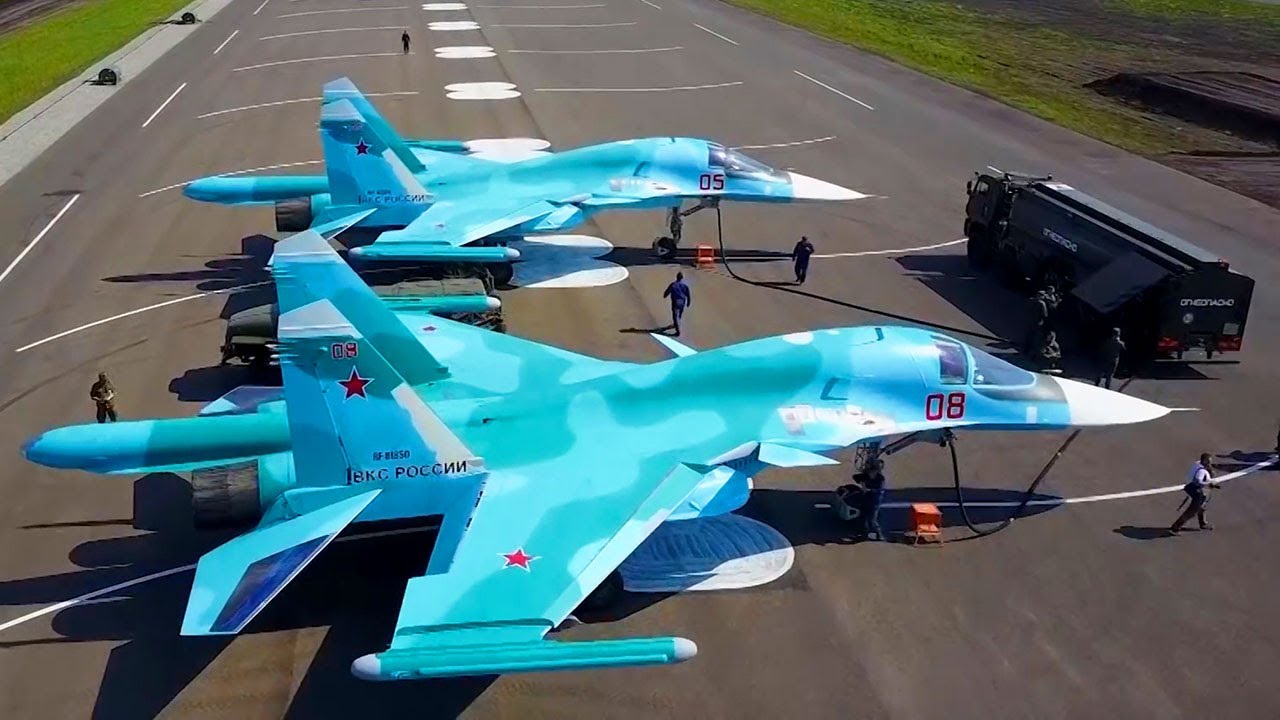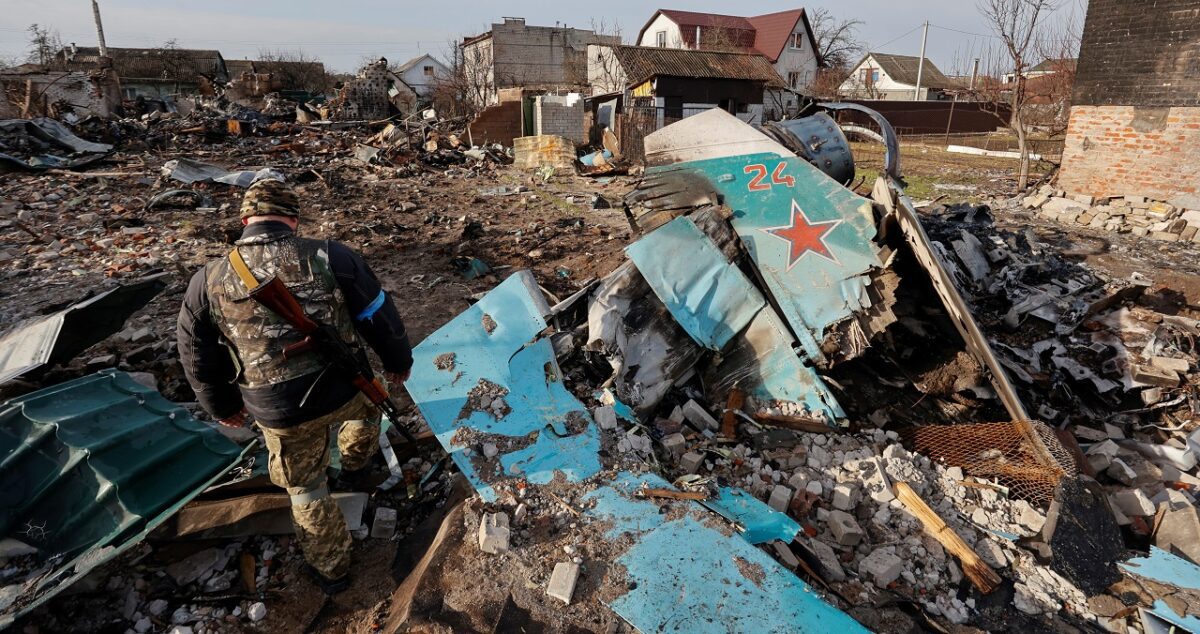A video recently emerged of Russia’s most advanced strike aircraft, the Su-34 Fullback, flying very low and dropping bombs on Ukrainian positions.
In the video footage, the Fullback can be seen flying at ultra-low altitude and dropping several unguided bombs that explode after the aircraft leaves the strike zone, suggesting the bombs are equipped with delay fuse.
“A Su-34 drops bombs Jaguar style!” remarked Squadron Leader Vijainder Thakur, a retired Indian Air Force Jaguar pilot and an analyst/columnist with The EurAsian Times.
The SEPECAT Jaguar is an Anglo-French jet attack aircraft originally used by the British Royal Air Force (RAF) and the French Air Force in the close air support and nuclear strike role. It continues to be in service with the IAF.
A Su – 34 drops bombs Jaguar style! Russians criticise their Air Force for exposing 4.5 gen fighters to MANPADS, the West says Russia is desperately short of PGMs pic.twitter.com/6g2lyUaWpa
— Vijainder K Thakur (@vkthakur) October 28, 2022
Jaguars played an essential role in the 1999 Kargil War, with the IAF employing them for deep penetrating strikes using unguided and laser-guided bombs.
India is retaining the Jaguar fighter bombers for delivering nuclear gravity bombs, making them an essential part of the country’s nuclear triad.
Thakur explained that the Jaguar was among the first few fighters to drop a bomb accurately in level flight, while earlier aircraft would drop their bombs in a dive towards the target.
The Jaguar would use its flight computer and inertial platform to compute the prevailing wind direction and speed to account for the wind’s impact on the air-dropped bomb’s trajectory.
“Taking into account the speed of the aircraft and the height at which it is flying, the computer could accurately indicate to the pilot when to drop the bomb,” Thakur said while noting that because of this capability, a Jaguar did not have to climb up and dive close to the target, exposing itself to enemy air defense weapons.
“It could penetrate adversary airspace at 200 feet above ground level, drop its ordinance from the same height, and exit at full speed from the target area, maintaining low height, avoiding radar detection,” Thakur said.
According to Thakur, unguided bombs could be as accurate as precision bombs when dropped from extremely low levels. “From my experience in Jaguars, you can easily get 5m accuracy when releasing a bomb from 200-ft,” he said.
Russia Using Most Advanced Fighters To Drop Archaic Bombs
While flying low does allow the aircraft to evade the detection by enemy air defense radars, the trade-off here is that the plane becomes vulnerable to attack by Man Portable Air Defense Systems (MANPADS).
Russia and Ukraine have employed MANPADS to a great extent in their air-denial strategy against each other.
Su-35 dropping bombs from a very low height and being fired on from a Manpad pic.twitter.com/xDxeNrA20r
— Reggie Meezer (@ReggieMeezer) October 25, 2022
A retired-Russian fighter pilot admitted the effectiveness of Ukrainian MANPADS in a recent interview with EurAsian Times.
“Most of our Su-35s, Su-24s, and Su-34s have been hit while flying at low altitudes,” a retired Russian pilot told EurAsian Times, who requested anonymity.
The Su-34 Fullback is Russia’s most advanced strike aircraft. While it is highly equipped to conduct precision air-to-surface strikes from stand-off ranges, the aircraft is instead mainly employed for old-fashioned seek-and-destroy missions, which involve the aircraft going to the target area, visually acquiring the target, and then attacking.

This is also the case with Russia’s other advanced combat aircraft, such as the 4.5 generation Su-35 multirole fighter jet.
The severe depletion of its inventory of precision-guided munitions has prompted the Russian military to rely heavily on unguided bombs. Ukrainian intelligence believes Russia has already fired 55% of its entire stockpile of guided missiles.
According to the General Staff of Ukraine, before the beginning of the Russian Military Operation on February 24, Russia had 900 Iskander-M missiles, 500 Calibre missiles, and 440 KH-101 missiles.
Following eight months of operations, the stocks of the missiles are estimated to have reduced to around 100 Iskanders and a little more than 200 Calibre and KH-101 missiles each.
This dire state of its precision-guided capability has forced the Russian Air Force (VKS) to use its advanced fighter jets in a very old-fashioned way by flying them within the range of MANPADS to attack ground targets with archaic bombs.
Merits Of Russia’s Tactic!
Nevertheless, this tactic has its merits, as mentioned in a recent EurAsian Times article.
Russia tends to favor affordability over capability in its weapon systems, as affordable weapon systems increase Russia’s capacity to absorb losses when fighting a protracted conflict against an adversary like Ukraine that has been receiving an unending supply of equipment and ammunition from the West.
Russian fighters are equipped with Missile Approach Warning (MAW) sensors to detect MANPAD launches, automated flare dispensing, and wingtip-mounted Khibiny Electronic Warfare (EW) pods to evade incoming missiles.
The flares confuse the Infrared (IR) sensors aboard the anti-aircraft missiles used for guidance. The Khibiny EW pods are intended for detecting emissions of air defense radars and missiles and spoofing active seekers aboard incoming missiles.
“Downing a Su-34/35 with a MANPAD requires a tremendous amount of luck, but in a long conflict, you could get lucky,” says Thakur.
As EurAsian Times discussed earlier, Su-34 is one of Russia’s most widely deployed combat aircraft in the ongoing Ukraine war, and therefore also the one that has met with several casualties – either going down in a crash or being knocked down by Ukrainian air defenses.

So far, 17 confirmed Su-34 combat losses had been registered during the conflict by the military tracking blog Oryx based on visual confirmations. One of them is the upgraded Su-34M, which is reportedly a case of friendly fire.
#Ukraine:A Russian Su-34 strike aircraft was shot down, likely in the vicinity of Alchevsk, #Luhansk Oblast.
According to preliminary information, it was likely to be a case of friendly fire. pic.twitter.com/4DIzPE8Y5N
— ?? Ukraine Weapons Tracker (@UAWeapons) July 18, 2022
This is doubtful, considering the first batch of Su-34M was delivered to the VKS at the end of June, and the Su-34 in question was shot down in mid-July.
- Contact the author at tanmaykadam700@gmail.com
- Follow EurAsian Times on Google News




